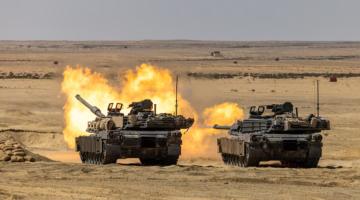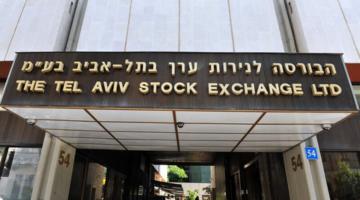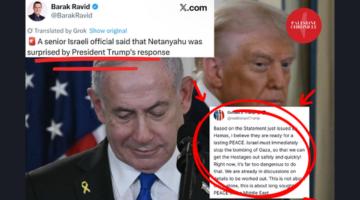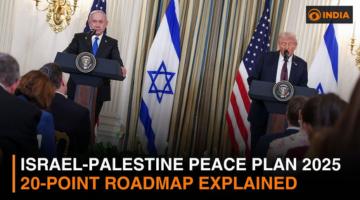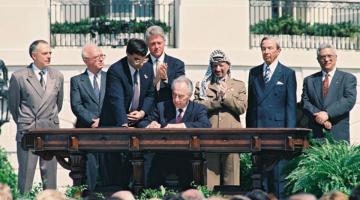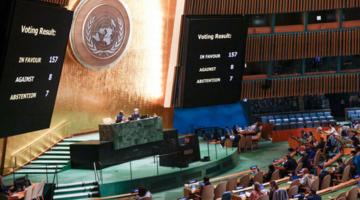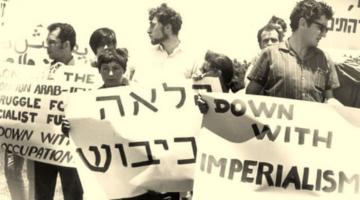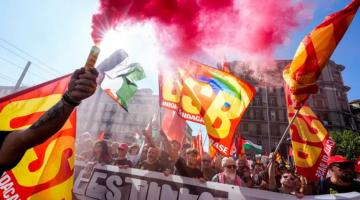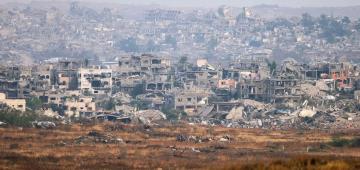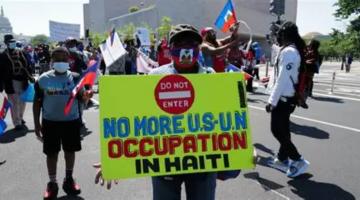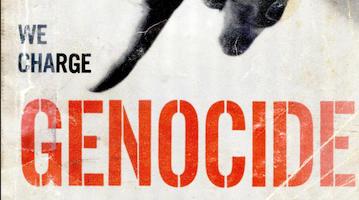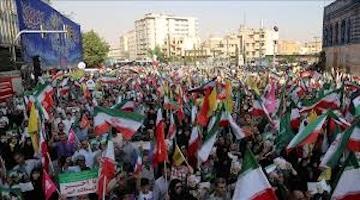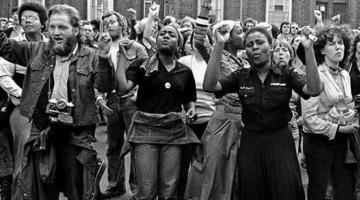Children waving Palestinian flags as Palestinians returned to Rafah city, celebrating the announcement of ceasefire. Photo: Abed Rahim Khatib/Anadolu via Getty Images
For 76 years, Gaza has been has been the defiant heart of Palestinian resistance. Today, as Israel’s genocidal war lays bare the brutal dead end of Zionism, Gaza’s struggle transcends geography, bringing a global reckoning with colonialism, oppression, and the cost of silence.
Originally published in In These Times.
When Israel was established in the Nakba of 1948, it was built on top of 78% of historic Palestine, destroying more than 500 Palestinian towns and villages and forcefully displacing more than 750,000 people.
But one small strip of land remained beyond the Israeli conquest.
It was just a fraction of what had been taken by Zionist militias, but this small territory of 140 square miles — the Gaza Strip — would emerge not only as a site of resistance to Zionism, but as a force that would challenge colonialism, imperialism and apartheid both globally and locally.
It is, as Palestinian storyteller Mahmoud Darwish would write in the poem “Silence for Gaza,” translated from the Arabic by Sinan Antoon, equal to “the history of an entire homeland, because it is more ugly, impoverished, miserable and vicious in the eyes of enemies.”
“Because it is the most capable, among us,” Darwish wrote, “of disturbing the enemy’s mood and his comfort.”
Of the total number of Palestinians displaced in 1948 by Zionist militias — which carried out massacres and atrocities across historic Palestine — 250,000 were forced from their homes into what would later become the Gaza Strip. This changed the demographics and social structure as the displaced Palestinians joined existing residents.
The borders of the Gaza Strip, originally drawn as cease-fire lines following the Arab-Israeli War of 1948, were not considered official borders, even by the warring parties. What those demarcations did was sever Gaza from the rest of Palestine and cause unprecedented fragmentation geographically, economically, socially and culturally.
In 1955, Palestinian author Khalil Totah published the findings of his visit to Gaza to document the devastating economic collapse the city faced. Once a thriving agricultural hub, Gaza’s wheat and barley fields, which stretched to Beersheba, were gone, along with its orange groves in villages like Dayr Sunayd and Hiribya. The olive orchards, fruit and vegetable gardens and all other sources of sustenance had been stripped away.
Once a bustling marketplace which connected villages and nomads, Gaza lost its vital trade. Its streets, once filled with commerce, left the city an economic void. Describing the depth of the suffering, Totah wrote: “The inhabitants of Gaza seemed to be in a concentration camp or perhaps in a tomb. The atmosphere was most depressing, yet the people are bravely carrying on. It is a siege, indeed, and life is on a day-to-day basis.”
It is impossible to see the Gaza Strip as anything but Israel’s creation, driven by a violent, organized campaign of geographic and demographic reengineering. This dynamic continues today: Israel as the colonizer, violently clashing with Palestinians as the colonized, forming the central drive and argument at the heart of this continuation of the 76-year-old Nakba.
At its core, the Palestinian struggle today is not only about defending the rights of the Palestinian people; it has a universal dimension and deep global implications, all of which are playing out in the Gaza Strip.
Palestine has become a crucial battleground in the confrontation against the marriage of traditional colonial visions — like those that shaped the history of the United States and allowed the Israeli settler-colonial model to metastasize in its most extreme form — and the 21st-century agenda of political exclusion that strips human and civil rights from large, disadvantaged groups.
This colonial approach fundamentally relies on dehumanization to justify the extermination, the isolation, or the complete or partial denial of the fundamental human rights of the colonized.
While the birth of the Gaza Strip itself was a violent event, after 1948, it became the target of relentless and extreme violent measures. From being reduced to a vast refugee camp and open-air prison to enduring repeated military incursions and aggressions, Gaza has faced systematic attempts to displace its population — sometimes through forced displacement to distant lands, other times through the imposition of suffocating conditions that make life unbearable. The encroachment of settlers on its already limited space, the deliberate destruction of its economy, the massacres committed and quickly forgotten, and brutal campaigns designed to crush Palestinian resistance — including breaking bones, exile and severe restrictions on movement — form part of a larger strategy of oppression.
Tactics like these, alongside indiscriminate bombardment and psychological warfare, are weaponized against Palestinians with varying degrees of intensity and brutality. There is little complicated about the power dynamics: Zionism is the colonial force animating the oppression and attempts to ethnically cleanse Palestinians; conversely, the Palestinian national movement is the resistance and liberation struggle against apartheid and colonial rule. Gaza has long been a frontline in this struggle.
From the anti-resettlement uprising of the 1950s, to the insurgency against Israel’s occupation in the 1960s and early 1970s following the Six-Day War, to the First Palestinian Intifada—which marked a pivotal shift in the history and politics of the Palestinian struggle — Gaza has consistently been at the forefront of resistance.
To Israel, the Gaza Strip represents its antithesis.
On one side, Israel has sought to secure the gains it achieved in 1948, expand its occupation and reduce the number of Palestinians. On the other side, Palestinians have resisted — by countless means — Israel’s attempts to normalize the Nakba as a repeatable historical precedent.
The armistice line that separated the Gaza Strip from the lands occupied in 1948 became a lasting front of confrontation. At every stage of Israel’s attempts at eradication and displacement — regardless of scale or intensity — resistance emerged in response.
Thousands of Palestinians tried to return to occupied lands in the aftermath of the Nakba — whether for harvesting their crops and orchards, retrieving possessions or reuniting with separated family members — and Israel responded with extreme violence, including landmines along the border.
In 1956 – 57, Israel occupied the Gaza Strip as part of the Tripartite Aggression and invasion of Egypt, killing, arresting and torturing thousands of members of Gaza’s population. Despite the brutality, 1957 also marked a moment of political victory for Egypt and Gaza when Israel withdrew — the first Israeli retreat from Palestinian and Arab lands occupied after 1948.
After the Six-Day War of 1967, political economist Sara Roy introduced the term “economic de-development” to describe how Israel systematically dismantled Gaza’s economy through various mechanisms, including land confiscation, labor dependency on Israel, and severe restrictions on trade and movement.
By 1987, external payments (mainly wages earned in Israel) accounted for 42% of Gaza’s Gross National Product (GNP), highlighting extreme economic dependency, with Gaza’s overall economy equaling just 1.6% of Israel’s Gross Domestic Product (GDP). Israeli policies further entrenched this dependence by expropriating large amounts of agricultural land, restricting Palestinian access to water, and preventing investment in infrastructure, banking and trade regulations.
By the early 1990s, under Israeli rule, Gaza’s largest refugee camp, Jabalia, had a population density of 133,400 people per square mile — more than twice that of Manhattan — while Israeli settlers, who made up just 0.5% of the population, were allocated 84 times more land and consumed 16 times more water per capita than Palestinians.
Roy argued these policies were designed to keep Gaza in a state of dependency and stagnation. Tens of thousands of Palestinian workers were funneled into low-wage, exploitative jobs in Israel — often in construction, agriculture and menial labor — while being denied basic labor rights, social benefits and job security, effectively turning them into a disposable workforce.
Israel also established Jewish settlements on nearly 20% of the Strip’s land, according to the Jewish Virtual Library, seizing most of its fertile areas and water resources.
But various forms of resistance in the Gaza Strip continued to emerge.
The absence of serious discussion about Gaza before October 7 reflects a world willing to normalize a situation in which the humanity of millions of people was systematically stripped away, in which rights were denied on a massive scale— decade after decade.
In response, Palestinians have drawn from a vast arsenal of resistance tactics and political approaches, testing and deploying different methods at different times. They have engaged in mass popular mobilization, as in the First Intifada, in which they embraced civil disobedience and nonviolent protest in its many forms. They have sought change from the outside, appealing to global conscience to shift hearts, minds and policies. They have turned to armed struggle, as seen in various moments in the past century. They have pursued diplomacy and engaged in negotiations in hopes of a peaceful resolution. At times, they re-established the agenda of armed struggle following the failure of diplomacy, while at other times, they have paused armed struggle to return to unarmed mass mobilization, as was the case with the Great March of Return.
Each of these moments has been met with a familiar response: Israeli violence and repression, the dismissal of Palestinian demands, and the demonization of those who resist — regardless of their ideology, approach or methods. The result remains unchanged. Palestinians found themselves stuck in an unrelenting cycle that was crushing any of their hopes for freedom, especially in the past three decades.
For most of their struggle, Palestinians faced minimal support from the Arab world and the international community. But by the late 2010s and early 2020s, this indifference turned into active betrayal, with regional forces not just abandoning them, but conspiring against their cause.
By 2023, it seemed to many that the Palestinian cause was over.
After Israel realized “managing Gaza” through “mowing the grass,” periodic military operations, was unsustainable, Israel swiftly shifted from these strategies to a phase of annihilation.
An explosion between the river and the sea was inevitable — a question of when, not if. The convergence of international, regional and local factors, fused with a looming sense of an existential reckoning for Palestinians — especially in the West Bank — accelerated its eruption. This was only intensified by the rise of the most far-right government in Israel’s history, led by ministers and politicians who openly call for a second Nakba, the mass expulsion of Palestinians and for erasing Palestine as a political question. In other words, genocide was no longer just an unspoken threat — it had become an explicit goal.
Months before October 7, Israeli finance minister Bezalel Smotrich called for wiping out the town of Huwara in the West Bank. A year later, he called for “total annihilation” of Gaza.
These statements are not marks of strength or confidence, as Smotrich and his ilk believe. They are the echoes of a failed project, the admissions of a state exhausted by its own futility — trapped in the endless cycle of trying, and failing, to erase a people who refuse to disappear. They reveal not power, but the desperation of a supremacist vision crumbling under its own weight.
The war of extermination that unfolded in Gaza over 16 months — that could reignite at any moment — was the culmination of the Zionist settler-colonial project and a concrete acknowledgement that it had hit a dead end.
This explosion, which we have lived through and continue to witness, was inevitable. The reality in Gaza, for decades, required attention. Yet, there were no serious efforts from the international community, regional actors, or even certain Palestinian forces to envision solutions to the challenges and crises that Gaza increasingly faced.
For instance, when discussing Gaza’s demographic reality, the United Nations predicted in 2016 that, by 2050, the population of Gaza was expected to more than double — from 2.2 million before the current extermination campaign to 4.5 million. This meant the population density in Gaza, already among the highest in the Middle East, would have doubled from 6,000 people per square kilometer (15,540 people per square mile) to 14,000 people per square kilometer (36,260 people per square mile).
The UN’s 2012 warning that Gaza would be unlivable by 2020 was not just ignored — it was fulfilled.
One of the most significant developments in the Middle East over the past decade has been the emergence of a new track of Arab-Israeli normalization, which eventually led to the so-called Abraham Accords, a series of agreements between Israel and several Arab states aimed at establishing diplomatic and economic ties.
Many Arab analysts and others interpreted this normalization track as an attempt by the United States to maintain its regional influence by establishing an Israeli-Arab alliance built on security, military and intelligence cooperation. It was aimed at curbing forces opposed to U.S. economic interests while promoting a set of values that were intellectually and morally inconsistent.
The Abraham Accords were also fundamentally premised on bypassing and minimizing the Palestinian cause. The agreements rested on the assumption that strategic arrangements could be made between Arab states and Israel without resolving the Palestinian issue or granting Palestinians their rights.
Even more troubling was the implicit — sometimes explicit — acceptance by some Arab forces supporting the Abraham Accords that Palestinians should settle for economic scraps in the form of job opportunities and economic incentives, while Israel continued to steal their land, desecrate their holy sites and expand its settlements.
This effectively envisioned the remaining Palestinians in the West Bank being confined to walled-off Bantustans, from which they would emerge to work in a captive economy under occupation, while Gaza remained under perpetual blockade.
By 2023, many Palestinians had come to realize that they were facing a massive regional endeavor aimed at burying their political cause forever, as an emerging Arab-Israeli alliance sought to “Israelize” the region. This process was being cemented through violence, surveillance and the systematic violation of people’s privacy — manifesting in the adoption of Israeli repression tactics by certain Arab regimes, such as the use of Pegasus spyware.
Even more dangerously, some Arab writers argue that, during and after the Arab uprisings, certain economic, political and security elites in the region began to see the Israeli settlement model — fortified by fences and barbed wire — as a system worth replicating.
“Inside these settlements,” wrote the Egyptian intellectual Mohamed Naeem, “a privileged population enjoys high standards of living, while millions of marginalized, dispossessed individuals remain stripped of their rights and dignity.” “For contemporary Arab state regimes,” Naeem continued:
Israel serves as an example of how the military and security institutions can efficiently and effectively control a country while allowing for a disciplined form of democratic political life under their dominance. For fundamentalist movements, Israel is the model of a modern state that uses religion as a common ideological framework to unify its citizens and sustain their collective zeal. Meanwhile, for socalled Arab liberals, Israel provides a space for freedom of thought and expression greater than that of any Arab country. …
The underlying principle is separation — whether through walls, armies and checkpoints or through security forces trained to handle second-class citizens.
These elites came to view their own populations, who demanded social justice, economic equity and political rights, as “Palestinians” who needed to be suppressed, intimidated and forced into Gaza- or West Bank-like conditions, stripped of even their most basic rights. And if necessary, these regimes would resort to systematic violence against them — akin to Israel’s policy of mowing the grass — branding them as “terrorists” to strip them of their humanity and justify their elimination, whether as individuals or en masse.
Yet, they’ve largely been deprived of the power to change their reality, as they are trapped behind both physical and invisible walls of deprivation, exclusion and systematic violence.
Gaza erupted out of this context in October 2023; the prior May, I had written for In These Times that a second Nakba was imminent.
Shortly before the 15 anniversary of Israel’s unilateral withdrawal — while creating a blockade — from the Gaza Strip in 2005, Israel’s Channel 11 aired a report featuring interviews with various high-ranking officials — most of whom had participated in security, military and settlement activities related to Gaza at different stages of their careers.
Among them were former prime minister Ehud Olmert, former military intelligence chief Aharon Ze’evi-Farkash, former Shin Bet chief Avi Dichter and former defense minister Moshe Ya’alon.
The central question posed was about the future of Israel’s relationship with Gaza and how these leaders envisioned the Strip’s future. The responses varied — some spoke about maintaining the status quo and mowing the grass when necessary, while others asserted that an assault similar to Operation Defensive Shield, a 2002 large-scale Israeli military offensive in the West Bank, was inevitable.
Some proposed that Gaza’s fate would be annexation by either Egypt or Israel. In the latter case, they suggested that only those who surrendered to Israel’s authority would be allowed to stay, while the vast majority of Gaza’s population would be forcibly removed.
When the reporter asked settler activist Tzvi Hendel where Palestinians should go under this plan, Hendel responded, “They should leave — to Canada, I don’t know where.”
Indeed, Israeli leaders may not know where they want the people of Gaza to go, but Israel’s approach makes it clear that they see Gaza’s population as a surplus and a burden. This is especially true given that Gaza has remained a hub of resistance, continually regenerating its ability to resist even under the harshest conditions over the past seven decades.
Shortly before October 7, President Joe Biden’s administration told reporters the Middle East was “quieter today than it has been in two decades.” This was not only wrong, but extremely dangerous because it carried an agenda to bury the Palestinian cause while helping normalize Israel’s regional presence.
On Palestine, rather than reversing course, Biden expanded Trump’s approach from his first term. He actively pursued expanding the Abraham Accords by pushing for Saudi-Israeli normalization and granted Israel inclusion in the U.S. Visa Waiver Program, even as the Israeli government faced mass protests over its controversial judicial overhaul. More alarmingly, genocidal rhetoric and calls for ethnic cleansing and displacement were becoming regular features of the discourse echoed at the highest levels of power in Israel.
Genocidal tendencies do not emerge suddenly, nor do societies become genocidal overnight. These tendencies are deeply rooted in an ideology that negates all forms and expressions of Palestinian existence — politically, culturally, historically and even biologically.
In 2021, academics Ivar Ekeland and Sara Roy published “The New Politics of Exclusion: Gaza as Prologue,” in which they argue that Gaza became a prototype for modern exclusionary policies — a laboratory for a new, modern political system that systematically excludes an entire population from basic rights and political life, reducing them to a mere biological existence, dependent solely on humanitarian aid.
This approach renders Palestinians invisible and eliminates them from any form of political engagement, demonstrating a new model of control and exclusion that could be adopted elsewhere.
These politics allowed Israel to perpetuate the blockade of Gaza, normalize Palestinian marginalization and extend this model on a broader regional scale through its emerging alliances and partnerships with actors who share its vision for the region.
However, this vision and these efforts collided with an event whose scale and consequences Israel had neither anticipated nor prepared for. The October 7 attack and the subsequent Israeli genocidal assault on Gaza forced both Palestinians and the wider region to confront existential questions and dynamics such as: How can there be regional security with a state like Israel in its midst — one that is willing to commit atrocities on a massive scale, carry out attacks like the Lebanon pager attack and orchestrate mass murder and displacement? And all so a politician like Israeli Prime Minister Benjamin Netanyahu can cling to power, or so that a project like Israel can sustain itself at the expense of every state and society in the region.
Israel’s genocidal war against the Palestinian people, particularly in Gaza, has shattered its carefully crafted image as a rational actor — one that claims to uphold democracy, champion science and technology and embrace a balance of modernity and tradition. The world and the region have now witnessed what Israel is capable of when it wields its military power with the full backing and protection of the United States — especially when its victims dare to resist or refuse to comply.
Today, Israel no longer feels the need to hide behind any facade. The language of extinction and ethnic cleansing is all too clear — and is echoed by Trump, who has absurdly proposed annexing Gaza, something that will not happen. In Israel’s highest political circles, genocide is not whispered behind closed doors — it is declared openly and casually: the defense minister calls Palestinians “human animals” to justify their genocide; the finance minister invokes biblical extermination to demand the “total annihilation” of entire cities; a ruling party lawmaker calls for a new Nakba “that will overshadow 1948”; and another Knesset member outright suggests using nuclear weapons to “crush and flatten” Gaza.
As the Zionist project had hit a dead end, it has now fully transitioned into a phase of extreme violence and brutality — not only against Palestinians, but against Lebanon and Syria, where Israel continues to occupy land, displace people and threaten invasion and further occupation.
The coming phase of genocide could be even bloodier and more difficult as Israel collides with both the Palestinians and the broader region, attempting to entrench itself further through sheer force.
All of this is in pursuit of an illogical project — one based on monopolizing land, narrative and history in a region that is among the richest and most diverse in the world.
In this context, calls for Palestinian displacement from Gaza or the West Bank are not an isolated policy but part of a broader far-right fascination with Israel’s model of militarized containment, ethnic re-engineering and settler colonialism — an approach that has been embraced by right-wing fascist movements globally as a blueprint for demographic control, apartheid governance and the normalization of mass displacement.
Yet a new generation is emerging — in Gaza, the West Bank, the Arab world and beyond. They have looked closely at Gaza’s experience, seeing its people not only as hapless victims but also as a model of patience, resilience and defiance.
They refuse to accept a global agenda that seeks to strip entire communities of their rights and dignity — communities that can be discarded without noise, protest or consequences.
This is the universal lesson of Gaza. What is happening there is not just about Gaza; it is about how we all see and understand the world we live in.
The Palestinian struggle is the story of a people who refuse to be erased, exterminated or displaced simply because another party has the power to do so — and is encouraged by international actors that enable and support such extermination and displacement. While many portray the Palestinians’ refusal to accept their erasure as an irrational rejectionism, the day may come — perhaps soon — when many in the world will return to the story of Palestine and read it differently.
Palestinians have repeatedly and persistently attempted, over decades, to present narratives about their contemporary struggle — narratives that, if Western audiences were to read with true reflection, would reveal that the Palestinian struggle has nothing to do with hatred of Jews, antisemitism or any of the accusations that Israel and its allies insist on promoting.
They will see it as the story of a people who rejected the continuation and establishment of dangerous precedents rooted in colonialism, ethnic cleansing and the displacement of indigenous populations to replace them with others.
In this moment, the natural questions for us to ask are: Will this be a world of settlers, billionaires and gated settlements where safety, rights and resources are reserved for a privileged few at the expense of the many? Or will this be a world where equality, human dignity and respect for people and land take precedence?
One thing we know affirmatively, however, is that the Zionist project is a bloodthirsty one, and it can only exist on the murder and genocide of the Palestinian people, and on more and more bloodshed, and on more and more war with Arab nations in the Middle East.
While the project had hit a dead end, it is now back to its roots of ethnic cleansing in full force and has nowhere to go but in pursuit of that goal.
As Darwish continued in “Silence for Gaza”:
They might break its bones.
They might implant tanks on the insides of its children and women.
They might throw it into the sea, sand, or blood.
But it will not repeat lies and say “Yes” to invaders.
It will continue to explode.
It is neither death, nor suicide. It is Gaza’s way of declaring that it deserves to live.
And while there is no definitive answer to the existential questions that surround the Zionist project, we can, at the very least, say this: there is a group of people in this world who have taken it upon themselves to rebel.
To refuse to leave their homes.
To say no.
Jehad Abusalim is Executive Director of the Institute for Palestine Studies — USA and coeditor of Light in Gaza: Writings Born of Fire.

